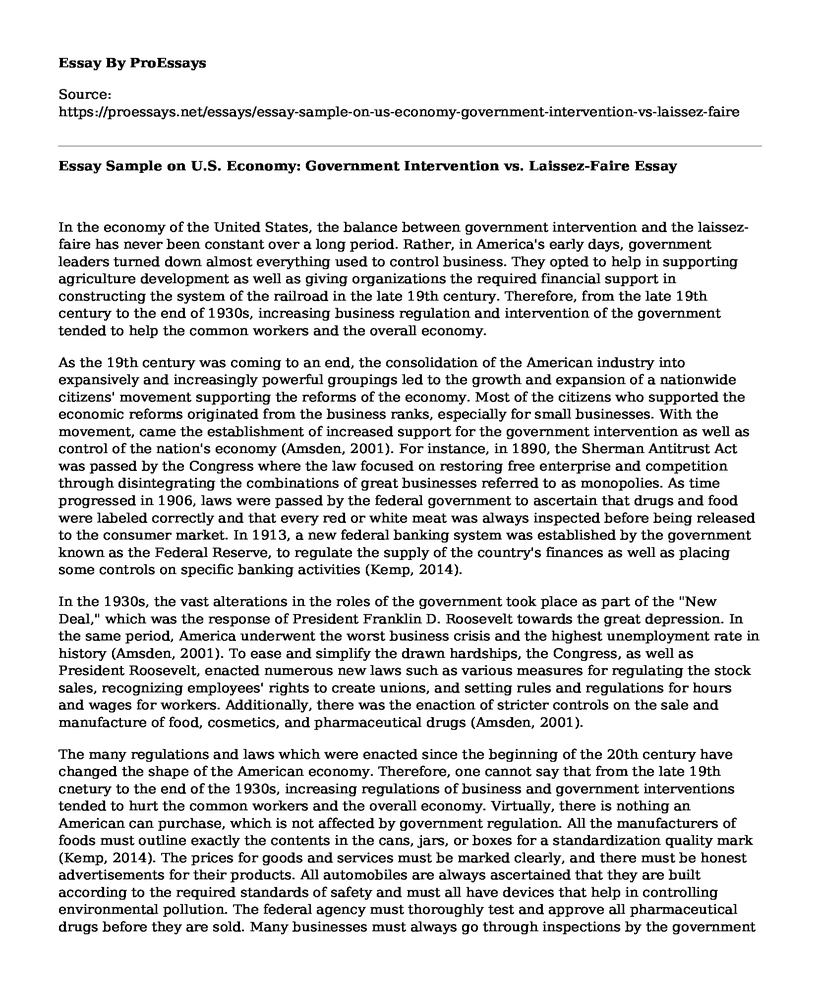In the economy of the United States, the balance between government intervention and the laissez-faire has never been constant over a long period. Rather, in America's early days, government leaders turned down almost everything used to control business. They opted to help in supporting agriculture development as well as giving organizations the required financial support in constructing the system of the railroad in the late 19th century. Therefore, from the late 19th century to the end of 1930s, increasing business regulation and intervention of the government tended to help the common workers and the overall economy.
As the 19th century was coming to an end, the consolidation of the American industry into expansively and increasingly powerful groupings led to the growth and expansion of a nationwide citizens' movement supporting the reforms of the economy. Most of the citizens who supported the economic reforms originated from the business ranks, especially for small businesses. With the movement, came the establishment of increased support for the government intervention as well as control of the nation's economy (Amsden, 2001). For instance, in 1890, the Sherman Antitrust Act was passed by the Congress where the law focused on restoring free enterprise and competition through disintegrating the combinations of great businesses referred to as monopolies. As time progressed in 1906, laws were passed by the federal government to ascertain that drugs and food were labeled correctly and that every red or white meat was always inspected before being released to the consumer market. In 1913, a new federal banking system was established by the government known as the Federal Reserve, to regulate the supply of the country's finances as well as placing some controls on specific banking activities (Kemp, 2014).
In the 1930s, the vast alterations in the roles of the government took place as part of the "New Deal," which was the response of President Franklin D. Roosevelt towards the great depression. In the same period, America underwent the worst business crisis and the highest unemployment rate in history (Amsden, 2001). To ease and simplify the drawn hardships, the Congress, as well as President Roosevelt, enacted numerous new laws such as various measures for regulating the stock sales, recognizing employees' rights to create unions, and setting rules and regulations for hours and wages for workers. Additionally, there was the enaction of stricter controls on the sale and manufacture of food, cosmetics, and pharmaceutical drugs (Amsden, 2001).
The many regulations and laws which were enacted since the beginning of the 20th century have changed the shape of the American economy. Therefore, one cannot say that from the late 19th cnetury to the end of the 1930s, increasing regulations of business and government interventions tended to hurt the common workers and the overall economy. Virtually, there is nothing an American can purchase, which is not affected by government regulation. All the manufacturers of foods must outline exactly the contents in the cans, jars, or boxes for a standardization quality mark (Kemp, 2014). The prices for goods and services must be marked clearly, and there must be honest advertisements for their products. All automobiles are always ascertained that they are built according to the required standards of safety and must all have devices that help in controlling environmental pollution. The federal agency must thoroughly test and approve all pharmaceutical drugs before they are sold. Many businesses must always go through inspections by the government employees for compliance with safety, health, or both kinds of regulations (Amsden, 2001). The mentioned are just a few of how consumers are currently protected by the government.
Conclusion
In conclusion, most people's life and work today have been improved due to government intervention. The drawn history has impacted in my workplace as our employee rights are always protected. Moreover, the programs, laws, regulations, and roles of the federal government in the American economy has improved and expanded including primary efforts to meet the economic needs of the disabled, the old and the poor as well in protecting the environment.
References
Amsden, A. H. (2001). The rise of" the rest": challenges to the west from late-industrializing economies. Oxford University Press, USA. Retrieved from https://books.google.co.ke/books?hl=en&lr=&id=hPHevolsLKMC&oi=fnd&pg=PP9&dq=From+the+late+1800s+to+the+end+of+the+1930s,+has+increasing+government+interventions+and+regulations+of+business+tended+to+help+the+overall+economy+and+the+common+workers%3F&ots=LIDpttVtGt&sig=JXn52LfFAwLZ1aE8cdfzODMu0d0&redir_esc=y#v=onepage&q&f=false
Kemp, T. (2014). Industrialization in nineteenth-century Europe. Routledge. ISBN: 9781315836492
Cite this page
Essay Sample on U.S. Economy: Government Intervention vs. Laissez-Faire. (2023, Feb 11). Retrieved from https://proessays.net/essays/essay-sample-on-us-economy-government-intervention-vs-laissez-faire
If you are the original author of this essay and no longer wish to have it published on the ProEssays website, please click below to request its removal:
- President Eisenhower Doctrine Essay
- Essay Sample on Samurai: Mounted Archers of Japan's History
- Essay Sample on Globalization's Underside: Investigating Its Political, Economic, and Governmental Effects
- Essay Example on Becoming a Licensed Professional Clinical Counsellor in California
- Paper Example on Prescribing Opioids in US: Dentists Lead the Way
- Essay Example on Hurricane Katrina's Pre-Determined Effects on African-Americans in New Orleans
- Free Essay Example on The Godfather Doctrine: Examining US Foreign Policy







